Chindia 2014: Our Top 10 Stories You Don’t Want To Miss
There are many reasons for curious investors such as yourself to follow and care about the economic health of China and India, or “Chindia,” as the region is sometimes referred to. Fortunately for you, we closely monitor these two powerhouse markets and regularly report on them to keep you informed.
Both countries’ voracious appetite and need for natural resources have far-reaching implications for a few of our funds, most notably our Global Resources Fund (PSPFX), Gold and Precious Metals Fund (USERX) and of course China Region Fund (USCOX).
For every seven people on Earth, more than two and a half are either Chinese or Indian. Last year, China overtook its southwestern neighbor as the world’s largest purchaser of gold, and this year, China’s economy surpassed the U.S.’s on a relative basis, while India’s is gaining fast.
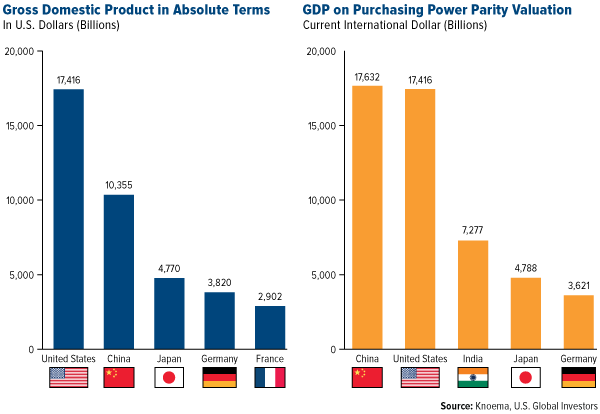
As I often say, government policy is a precursor to change, and both Asian giants have implemented new courses of action that have already made an impact on the funds mentioned above. With that in mind, let’s look back at 10 of the most important stories from 2014 involving China and India.
Keeping Tabs on China’s Favorites – January 22
In anticipation of the National People’s Congress Conference, China’s State of the Union Address, I noted that Premier Li Keqiang had invited several academics and corporate executives to advise him on what was vital to China’s economy going forward.
Of special interest were two tech entrepreneurs: Lei Jun, the “Steve Jobs” of China, and Pony Ma, CEO of Tencent.
I wrote that, because of Premier Li’s emphasis on tech, “we believe [China’s] technology and Internet areas are positioned to succeed in 2014.”
Indeed we were right, as Asian Internet stocks have outperformed U.S. American stocks.
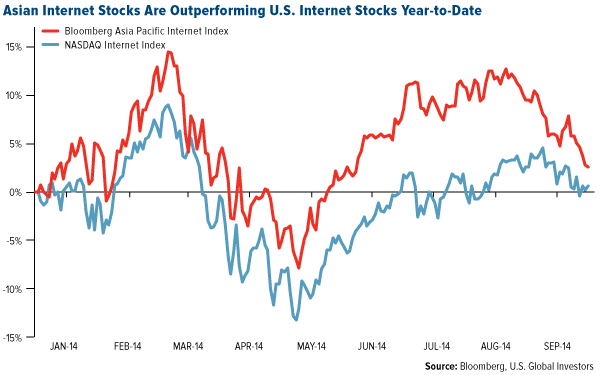
Follow the Money to Asia’s Tech Hub – March 17
In this Frank Talk, I proceeded with the Chinese tech theme, highlighting the country’s focus on innovation and a renewed entrepreneurial spirit.
At the time of writing, technology stocks in the MSCI Asia Index (excluding Japan) had increased an impressive 14.2 percent in the previous 12 months. Additionally, China had the best-performing technology market, beating rivals Taiwan and South Korea.
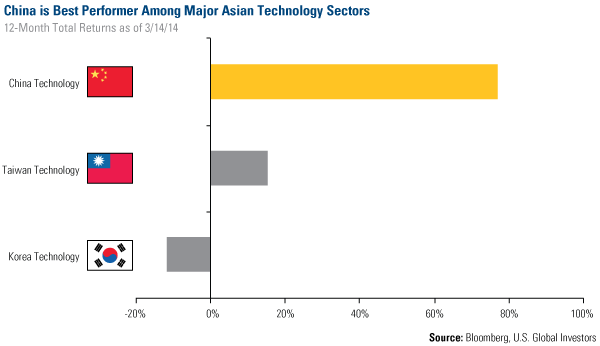
What India’s 815 Million Voters Have on Their Minds – April 10
As India was preparing to vote for its next prime minister, I discussed the issues and factors that might help sway the election’s outcome, two of the most important being urbanization and wealth accumulation.
“Urban dwelling usually is paired with an increase in wealth as city residents have more regular income,” I wrote, noting a surge in cell phone usage, television ownership and Internet connectivity.
“Every American born will need a whopping 2.9 million pound of minerals, metals and fuels in their lifetime,” I continued. “When you think about babies born in India, aspiring to the American lifestyle, you can begin to recognize the implications for resources demand in this part of the world.”
China Holds the Keys to the Gold Market – April 28
China’s middle class is growing larger and more robust every year, which helps support investments in fine metals and luxury goods, such as bullion and jewelry. Another driver of gold demand, on the rise as well in China, is industrial application.
In this Frank Talk I also discussed the reasons why China might be interested in pulling away from and limiting its exposure to the U.S. dollar. Little did we know in April just how strong the dollar would get later in the year and the actions China would take to position its own currency, the renminbi, as a viable alternative to the dollar in international trading.
China Leads the World in Green Energy, Gaming and Gambling Markets – June 9
The Asian gambling industry, especially in Macau, was on a tear back in June. But in November, gambling stocks took a nosedive by as much as 20 percent after the Chinese police announced they would begin investigating money laundering in the region.
However, the Chinese mobile-gaming market continues to thrive at an incredible rate, showing growth of 38 percent over the previous year. For the first time this year, the industry crossed the RMB100 billion mark, which amounts to about $15 billion, handily beating the $3.7 billion that was projected by year’s end.
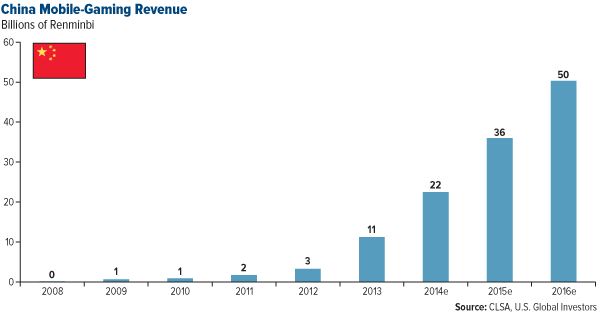
It’s Morning in India: Narendra Modi’s Pro-Business Policies Point to Strong Sectors Growth – May 29
In May, former tea merchant Narendra Modi was elected to take India’s top position as prime minister, bringing with him a promise to deregulate the free market, improve infrastructure and loosen gold import restrictions.
We’re already seeing some of what he promised come to fruition. In November his government scrapped the 80:20 rule, which mandated that 20 percent of all imported gold must be exported before any new shipments could be brought in. As a result, gold imports in November rocketed to 150 tonnes, a 571-percent increase over the previous year.
600 Million Reasons to Keep Your Eyes on India – October 6
And what do these 600 million Indians under the age of 25 have on their minds? Good-paying jobs. Adequate housing. A secure future. World-class infrastructure. An improved level of comfort.
All of this and more might be somewhere on the horizon under the leadership of Narendra Modi, who declared in a speech at Madison Square Gardens: “The 21st century will be that of India.” India’s consumer confidence is up, as are domestic car and truck sales.
CLSA’s Christopher Wood, recognized as one of the best Asian market strategists, asserted in September that he had “allocated 41 percent of [his] long portfolio to India.”
Not a bad strategy. The Bombay Stock Exchange Sensitive Index is up 32.7 percent year-to-date, making India the second-best-performing market among the BRIC countries, following China, whose Shanghai Composite Index is up nearly 50 percent.
As the Eurozone Stalls, China Cuts the Red Tape – October 27
In October I traveled to Italy to meet with other global chief executives and business leaders. There I heard from others just how imbalanced the European Union’s economic policies really are, “relying only on monetary policy but failing to address fiscal issues such as punitive taxation and over-bloated entitlement spending.”
The solution, as I see it, is to do what China has done: slash the regulations that stymie business and capital creation as well as jobs growth. Although China is also struggling to jumpstart a flagging economy, the numbers speak for themselves:
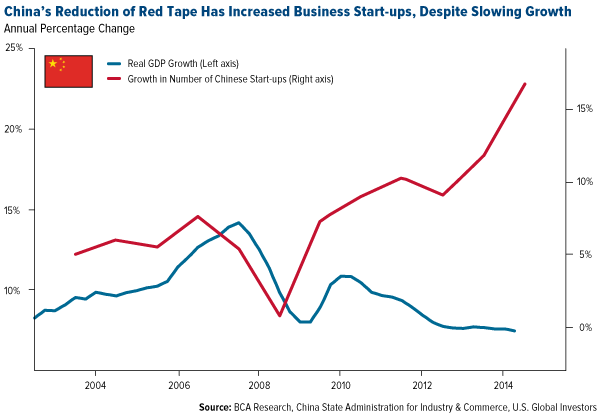
The Holiday that Jack Ma Built – November 13
2014 might very well be remembered as the year that Jack Ma’s Alibaba locked up for good its position as the world’s leading online marketplace and e-commerce payment hub. By the end of its 24-hour “Double 11” promotion, the company had generated—are you sitting down?—a record $9 billion in sales.
Compare that to disappointing Black Friday and Cyber Monday turnouts this year, and you would be blind not to see which way the wind is blowing.
As I wrote in this Frank Talk: “We’re seeing a tectonic shift in the online marketplace ecosystem and payment services. This shift is led not by eBay or Amazon.com so much as it is by Alibaba and other Asian e-commerce merchants.”
UPDATE: China Wants to Conduct the World’s High-Speed Rail Market – December 15
At a time when America’s rail lines are in desperate need of renovation and modernization, China is forging ahead with fast, efficient, high-speed rails. To date, over 80 percent of the world’s second-largest country is connected by high-speed rail, making travel for both business and leisure affordable and fast. By 2019, every corner of China is expected to be linked, which “makes the nation more energy- and time-efficient, and concentrates real estate development.”
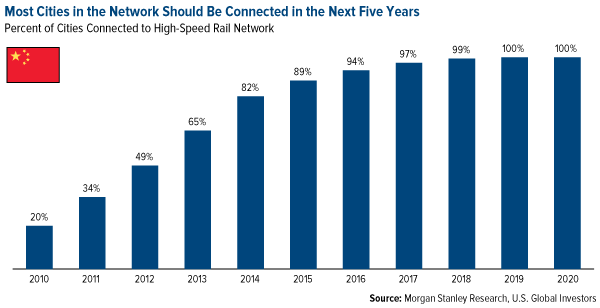
On top of that, China is aggressively seeking international buyers of its rail technology. Already it has contracts and pending negotiations the world over, the most notable being a $230 billion high-speed rail system connected Beijing and Moscow, which will largely replace the storied 100-year-old Trans-Siberian Railway.
Looking Ahead to 2015
Many exciting events and policy changes took place in the Chinese and Indian regions this year, and we eagerly look forward to seeing what else these two important economies have in store for 2015. We at U.S. Global Investors will continue to seek investment opportunities here and elsewhere around the globe, and continue to keep you informed with news, analysis and insight.
Later this week, keep an eye open for my top 10 commodities stories of 2014. You won’t want to miss it!
Please consider carefully a fund’s investment objectives, risks, charges and expenses. For this and other important information, obtain a fund prospectus by visiting www.usfunds.com or by calling 1-800-US-FUNDS (1-800-873-8637). Read it carefully before investing. Distributed by U.S. Global Brokerage, Inc.
Past performance does not guarantee future results.
Foreign and emerging market investing involves special risks such as currency fluctuation and less public disclosure, as well as economic and political risk. By investing in a specific geographic region, a regional fund’s returns and share price may be more volatile than those of a less concentrated portfolio. Because the Global Resources Fund concentrates its investments in specific industries, the fund may be subject to greater risks and fluctuations than a portfolio representing a broader range of industries.
Gold, precious metals, and precious minerals funds may be susceptible to adverse economic, political or regulatory developments due to concentrating in a single theme. The prices of gold, precious metals, and precious minerals are subject to substantial price fluctuations over short periods of time and may be affected by unpredicted international monetary and political policies. We suggest investing no more than 5% to 10% of your portfolio in these sectors.
The MSCI AC Asia ex Japan Index captures large and mid-cap representation across 2 of 3 Developed Markets countries* (excluding Japan) and 8 Emerging Markets countries* in Asia. With 603 constituents, the index covers approximately 85% of the free float-adjusted market capitalization in each country.
The Bloomberg Asia Pacific Internet Index is a capitalization-weighted index of internet companies from the Asia Pacific Region.
The NASDAQ Internet Index is a modified market capitalization-weighted index designed to track the performance of the largest and most liquid U.S.-listed companies engaged in internet-related businesses and that are listed on the NASDAQ Stock Market, the New York Stock Exchange (NYSE) or NYSE Amex.
The Bombay Stock Exchange Sensitive Index (Sensex) is a cap-weighted index. The selection of the index members has been made on the basis of liquidity, depth, and floating-stock-adjustment depth and industry representation. Sensex has a base date and value of 100 on 1978-1979. The index uses free float.
The Shanghai Composite Index (SSE) is an index of all stocks that trade on the Shanghai Stock Exchange.
BRIC refers to the emerging market countries Brazil, Russia, India and China.
Fund portfolios are actively managed, and holdings may change daily. Holdings are reported as of the most recent quarter-end. Holdings in the Global Resources Fund, Gold and Precious Metals Fund and China Region Fund as a percentage of net assets as of 9/30/2014: Alibaba Group Holding 0.42% in China Region Fund, Amazon.com 0.00%, eBay 0.00%, Tencent Holdings 5.62% in China Region Fund.
All opinions expressed and data provided are subject to change without notice. Some of these opinions may not be appropriate to every investor.







 Frank Holmes is the CEO and Chief Investment Officer of
Frank Holmes is the CEO and Chief Investment Officer of 










